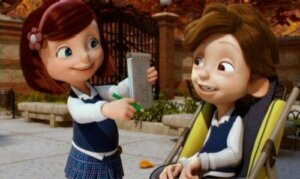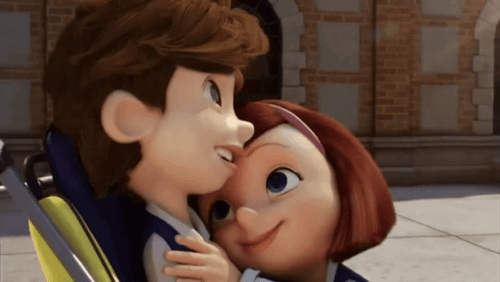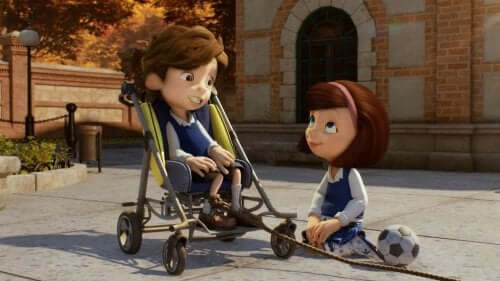A Wonderful Short to Teach Children About Inclusion and Friendship

“Cuerdas” is a wonderful short film that will teach our children the authentic value of respect, inclusion and friendship. Because no child is different if we approach them from the heart, those children we often label as “special” aren’t seeking a cure for their limitations. What they need most is our acceptance.
If you’ve never seen this short film, we strongly recommend it. Furthermore, we suggest that you watch it with the youngest members of your house because their understanding is more intuitive and they’ll react in a more sensitive way to this reality that we see in our school classrooms every day.
“Cuerdas” is a Spanish animated short film, written and directed by Pedro Solís García. He has won numerous awards and has been recognized around the world. Even though the film is in Spanish with English subtitles, it’s worth watching, and above all, feeling. What you’ll learn from these 10 minutes will leave a permanent mark on your adult minds and those of your children.
A short film about inclusion and friendship
If your children are already of school age, it’s very possible that, in their day-to-day lives, they’ll interact with children with special needs. The educational system favors the integration of these students in ordinary classrooms in certain subjects and later takes them to the special classroom where they reinforce basic learning and thus individualize teaching so that children achieve the objectives of each stage.

It should be said that it’s not always easy. Differences always cause certain expectations and even indifference, or worse, rejection.
The infantile world is even more complex, as not all children are prepared or have been educated to accept the differences in a person’s physical appearance or their physical or mental abilities. But beyond a child’s exterior lies a child like any other, a mind and a heart in need of affection, acceptance, joys, games, and complicity.
In this short film, we’re going to discover an unforgettable girl, María, and a little boy with cerebral palsy who faces his first day of class. What happens next is a wonderful story captured in almost 10 minutes, but in reality, it even extends to the adult life of Maria herself. That girl with a happy face and curious eyes.
Inclusion vs. Integration
In our day-to-day lives, we’re very used to hearing the word “integration”. We use it thinking that with this, we favor equal rights and opportunities for any group that’s disadvantaged for whatever reason.
However, we need to go much further than mere integration. We have to get used to talking about “inclusion” because it’s the best way for our children to understand what it is to grow in similarity, normalizing any person as part of our daily environments: Schools, jobs…
Let’s look at some basic characteristics of what inclusion means:
- Society itself is the one that must adapt to reach all people with disabilities. Not the other way around. Not forcing the child with special needs to fit into an environment they can’t even access.
- In an inclusive society, all of us, starting with children themselves, are sensitive to the needs of others. We strive not only to help but to make that person feel good about us. This is what our protagonist, María, does.
- The participation of excluded people is allowed and promoted for whatever reason to be part of our daily lives, and to guarantee this, there should be no doubt regarding the need to transform systems to provide them with quality.
- In an inclusive society, we’re all different and we’re all human beings. Needs are met and normalized.

Maria and the boy with cerebral palsy: A story of inclusion and friendship
The story begins in an orphanage. This is where the story of our two central characters unfolds: María and the little boy with cerebral palsy who comes to the classroom for the first time to be introduced.
At first, Maria isn’t aware of her new classmate’s limitations. However, when it’s time to go to the playground, the personal reality of her friend is more than evident. Now, far from seeing any problem in the child’s condition, Maria manages in a marvelous way to give him life, to make him smile, and to allow him to dream.
Believe it or not, this little girl is going to turn him into a pirate, play soccer with him, help him fly a kite, and even dance with him. How? With the help of ropes (“cuerdas” in Spanish) and the bond of affection, those ties that are anchored directly in the heart and that make the impossible possible.
We encourage you to watch the short film about inclusion and friendship, and above all, to enjoy it with your children. Even if they can’t read the subtitles, they’ll understand the message. When they’ve seen it, ask them what they felt and if they would have done the same as this girl with such a sincere, curious, and affectionate heart.
“Cuerdas” is a wonderful short film that will teach our children the authentic value of respect, inclusion and friendship. Because no child is different if we approach them from the heart, those children we often label as “special” aren’t seeking a cure for their limitations. What they need most is our acceptance.
If you’ve never seen this short film, we strongly recommend it. Furthermore, we suggest that you watch it with the youngest members of your house because their understanding is more intuitive and they’ll react in a more sensitive way to this reality that we see in our school classrooms every day.
“Cuerdas” is a Spanish animated short film, written and directed by Pedro Solís García. He has won numerous awards and has been recognized around the world. Even though the film is in Spanish with English subtitles, it’s worth watching, and above all, feeling. What you’ll learn from these 10 minutes will leave a permanent mark on your adult minds and those of your children.
A short film about inclusion and friendship
If your children are already of school age, it’s very possible that, in their day-to-day lives, they’ll interact with children with special needs. The educational system favors the integration of these students in ordinary classrooms in certain subjects and later takes them to the special classroom where they reinforce basic learning and thus individualize teaching so that children achieve the objectives of each stage.

It should be said that it’s not always easy. Differences always cause certain expectations and even indifference, or worse, rejection.
The infantile world is even more complex, as not all children are prepared or have been educated to accept the differences in a person’s physical appearance or their physical or mental abilities. But beyond a child’s exterior lies a child like any other, a mind and a heart in need of affection, acceptance, joys, games, and complicity.
In this short film, we’re going to discover an unforgettable girl, María, and a little boy with cerebral palsy who faces his first day of class. What happens next is a wonderful story captured in almost 10 minutes, but in reality, it even extends to the adult life of Maria herself. That girl with a happy face and curious eyes.
Inclusion vs. Integration
In our day-to-day lives, we’re very used to hearing the word “integration”. We use it thinking that with this, we favor equal rights and opportunities for any group that’s disadvantaged for whatever reason.
However, we need to go much further than mere integration. We have to get used to talking about “inclusion” because it’s the best way for our children to understand what it is to grow in similarity, normalizing any person as part of our daily environments: Schools, jobs…
Let’s look at some basic characteristics of what inclusion means:
- Society itself is the one that must adapt to reach all people with disabilities. Not the other way around. Not forcing the child with special needs to fit into an environment they can’t even access.
- In an inclusive society, all of us, starting with children themselves, are sensitive to the needs of others. We strive not only to help but to make that person feel good about us. This is what our protagonist, María, does.
- The participation of excluded people is allowed and promoted for whatever reason to be part of our daily lives, and to guarantee this, there should be no doubt regarding the need to transform systems to provide them with quality.
- In an inclusive society, we’re all different and we’re all human beings. Needs are met and normalized.

Maria and the boy with cerebral palsy: A story of inclusion and friendship
The story begins in an orphanage. This is where the story of our two central characters unfolds: María and the little boy with cerebral palsy who comes to the classroom for the first time to be introduced.
At first, Maria isn’t aware of her new classmate’s limitations. However, when it’s time to go to the playground, the personal reality of her friend is more than evident. Now, far from seeing any problem in the child’s condition, Maria manages in a marvelous way to give him life, to make him smile, and to allow him to dream.
Believe it or not, this little girl is going to turn him into a pirate, play soccer with him, help him fly a kite, and even dance with him. How? With the help of ropes (“cuerdas” in Spanish) and the bond of affection, those ties that are anchored directly in the heart and that make the impossible possible.
We encourage you to watch the short film about inclusion and friendship, and above all, to enjoy it with your children. Even if they can’t read the subtitles, they’ll understand the message. When they’ve seen it, ask them what they felt and if they would have done the same as this girl with such a sincere, curious, and affectionate heart.
All cited sources were thoroughly reviewed by our team to ensure their quality, reliability, currency, and validity. The bibliography of this article was considered reliable and of academic or scientific accuracy.
- Arias Martínez, B. y Fuertes Zurita, J. (1999). Competencia social y solución de problemas sociales en niños de educación infantil: un estudio obser- vacional. Mente y Conducta en situación educativa. Revista electrónica del Departamento de Psicología. Universidad de Valladolid, 1, (1), 1-40.
- Bandura, A. y Walters, R. (1974). Aprendizaje social y desarrollo de la personalidad. Madrid: Alianza.
- Lacunza, A. B., & de González, N. C. (2011). Las habilidades sociales en niños y adolescentes. Su importancia en la prevención de trastornos psicopatológicos. Fundamentos en humanidades, 12(23), 159-182. https://www.redalyc.org/pdf/184/18424417009.pdf
- Michelson, L., Sugai, D., Wood, R. y Kazdin, A. (1987). Las habilidades sociales en la infancia: Evaluación y tratamiento. Barcelona: Martínez Roca.
- Ovejero Bernal, A. (1998). Las habilidades sociales y su entrenamiento en el ámbito escolar. En F. Gil y J. León (comp.) Habilidades sociales. Teoría, investigación e intervención (pp. 169-185). Madrid: Síntesis Psicológica.
This text is provided for informational purposes only and does not replace consultation with a professional. If in doubt, consult your specialist.








